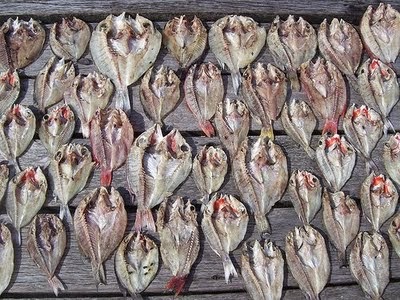Types of Illness The usual diseases attacking Arowana are as follows: A. White spot disease · Causes The cause of white spot disease is a multifiliic Ichthiopthirius protozoa. Factors supporting the cause of this disease are poor water quality, too low temperature, bad feed, and contamination of other fish that have been exposed to white spot disease. Transmission of this disease can be through water and direct contact between fish. · Symptoms Agian arowana body that is attacked is mucus cells, scales, and gill layer. Arowana who suffered from this disease seem difficult to breathe, often rubbed his body against the walls of the container, the emergence of white spots on the gills and fins, damaged mucous layer, and bleeding on the fins and gills.
B. Penducle disease · Causes This disease is often referred to as cold water descareases that can occur at a temperature of 160 C. the cause is Flexbacter psychropahila bacteria measuring about 6 microns. · Symptoms Arowana who is stricken with diseased disease appears weak, has no appetite, appearing ulcers or necrosis of the skin slowly. C. Edward siella's disease · Causes The cause is Edward siella terda bacteria measuring about 0.5-0.75 microns. · Symptoms If already infected with this disease, will appear small cuts on the skin and arowana meat, accompanied by bleeding. The wound will become a boil and release pus. Further attacks can cause injury to the liver and kidneys
D. Itchy disease
· Causes
The disease that often attacks arowana seed is caused by Trichodina sp. Parts of the body being attacked are skin, fins, and gills.
· Symptoms
Attack of itchy disease characterized by a weak arowana movement and often rubbing his body hard fist and container wall maintenance.
Tree of Natural Plants
A. Blood mole (Excoecaria cochinnensis Lour)
Blood shrubs are generally grown as ornamental plants or grow wild in the forests and planted in the yard as living fences or medicinal plants. This plant is a shrub plant that grows upright with a height of 0.5-1.5 meters and branched a lot. This plant can be propagated by stem cuttings or grafts.
Description: bd21504_ Properties and properties
This plant is efficacious to kill parasites (parasitides), eliminate itching (antipuritics), and stop the bleeding (hemostatis). It is warm and tastes spicy.
Description: bd21504_ Chemical content
Blood embers contain tannin, behenat acid, triterpenoid eksokarol, silosterol. And the sap contains resins and toxic compounds.
Description: bd21504_ Parts that can be used for medicine
The parts that can be used as medicine are the leaves, stems and roots.
B. Turmeric (Curcuma domestica Val)
Turmeric plants grow branching with a height of 40-100 cm. The stem is all stem, erect, round, rhizome form with a yellowish green color and composed of leaf midrib (slightly soft). The hairy and basilic compound of all shoots, 10-15 cm in length with a crown of about 3 cm and 1.5 cm wide, yellowish or yellowish. The tip and base leaf, but the leaves are flat. The outer skin of the rhizome is orange-brown, the flesh is orange red orange.
Description: bd21504_ Properties and properties
Turmeric is mendinginka. The substance in turmeric rhizome efficacious to inhibit or kill microbes.
Description: bd21504_ Parts that can be used for medicine
Turmeric part used as medicine is root tuber
C. How to manufacture extracts
Description: bd14583_ Blood Shed:
Before being made into an extract, the blood bone leaf should be washed first. The leaves are smoothed as much as 250 grams and added water as much as 50 ml. Once mashed the water is taken by filtering. The water that has been extracted is a blood glucose extract.
Description: bd14583_ Turmeric:
Before being made into an extract, turmeric rhizome is cleaned first. Rhizome that has been cleaned grated as much as 250 grams and added 50 ml of clean water. After shredded turmeric is extracted by filtering

